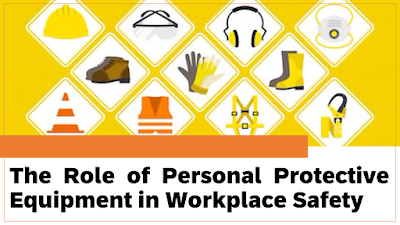The Role of Personal Protective Equipment (PPE)
in Workplace Safety
Personal Protective Equipment (PPE) is the basic essential in many workplaces as it provides the necessary protection to employees against hazards that may cause injury, illness. The Personal Protective Equipment (PPE) are considered as the last line defense in protecting employees from the hazards. PPE refers to protective clothing, safety helmets, goggles, gloves, respirators, and other equipment that is designed to protect the body from injury or infection. It is crucial for both employees and employers to understand the role of PPE in workplace safety.
Part 2 ADNOC & GULF HSE Interview Q & A
Importance of PPE
Employers have a legal and moral obligation to ensure the safety and health of their employees. The use of PPE is one of the ways to protect employees from the workplace hazards. PPE helps to prevent injuries and illnesses caused by exposure to hazardous materials, excessive noise, extreme temperatures, and other dangerous situations. It is also an effective way to protect employees from infectious diseases and other health hazards.
PPE Types
There are different types of PPE used in the workplace, and each type of PPE is designed for a specific purpose. Some common types of PPE include:
Head Protection:
This type includes safety helmets and hard hats that protect the head from impact injuries like fall of materials from height, strike with objects etc.
Eye and Face Protection:
This type includes safety goggles
and face shields that protect the eyes and face from hazardous materials,
debris, and other dangerous situations. Activities like welding, gas cutting,
chemical handling, working in process areas are some of the requirements of eye
protection.
Respiratory Protection:
This includes respirators that protect the lungs from harmful dust, fumes, and vapors. The half face or full face respiratory protection to be chosen according to the work activity. Respiratory protection is very important in safeguarding employees as the prolong exposure to hazards leads to various health issues to employees.
Hearing Protection:
This includes earplugs and earmuffs that protect the ears from excessive noise levels. The failure to use of effective hearing protection leads hearing loss like noise induced hearing loss and other health issues to employees who is not using.
Hand Protection:
This includes gloves that protect the
hands from cuts, burns, and other injuries. Hand protection is one of the major
personal protective equipment as most of the activities we engage our hands for
the execution.
Foot Protection:
This includes safety shoes and boots that protect the feet from falling objects, sharp objects, and electrical hazards. Foot protection is very important in any type of industry whether its construction or process industry.
Body Protection:
This includes coveralls, aprons, and vests that protect the body from hazardous materials, extreme temperatures, and other dangerous situations.
Choosing the Right PPE
Employers should conduct a hazard assessment to determine
the type of PPE that is required for each job task. The assessment should
identify the potential hazards that employees may encounter and the appropriate
PPE that will provide the necessary protection. It is essential to choose PPE
that is appropriate for the job task, fits properly, and is comfortable to
wear. Employers should also provide training to employees on the proper use,
care, and maintenance of PPE.
The Role of Employers
Employers have a responsibility to provide a safe working environment for their employees. This includes providing the necessary PPE to protect employees from hazards that may cause injury, illness, or death. Employers should ensure that PPE is readily available and in good condition. Employers should also provide training to employees on the proper use, care, and maintenance of PPE. Employers should monitor the use of PPE to ensure that employees are using it properly and effectively.
The Role of Employees
Employees have a responsibility to use PPE correctly and
to report any defects or damage to their employer. Employees should follow the
instructions provided by their employer on the proper use, care, and
maintenance of PPE. Employees should also notify their employer of any new
hazards or changes in the work environment that may require additional PPE.
The Benefits of Using PPE
The use of PPE provides many benefits to both employers and employees. Some of these benefits include:
Reduced Risk of Injury: PPE helps to prevent injuries and illnesses caused by exposure to hazardous materials, excessive noise, extreme temperatures, and other dangerous situations.
Compliance with Regulations: Employers who provide PPE to their employees are complying with legal and regulatory requirements.
Increased Productivity: Employees who feel safe and protected are more productive and motivated to work.
Reduced Costs: The use of PPE can help to reduce costs associated with workplace injuries and illnesses, such as workers' compensation claims, lost productivity, and healthcare expenses.
Improved Company Reputation: Companies that prioritize
workplace safety and provide adequate PPE to their employees are viewed as
responsible and caring by both employees and the public.
ISO 45001 INTERNAL AUDIT | ISO 45K – PART 3
Conclusion
Personal Protective Equipment is an essential component of
workplace safety. It helps to prevent injuries and illnesses caused by exposure
to hazardous materials, excessive noise, extreme temperatures, and other
dangerous situations. Employers have a legal and moral obligation to provide
PPE to their employees and to ensure that it is used properly. Employees have a
responsibility to use PPE correctly and to report any defects or damage to
their employer. The use of PPE provides many benefits to both employers and
employees, including reduced risk of injury, compliance with regulations,
increased productivity, reduced costs, and improved company reputation. By
prioritizing workplace safety and providing adequate PPE to their employees,
employers can create a safe and healthy working environment and ensure the
wellbeing of their workforce.

No comments:
Post a Comment